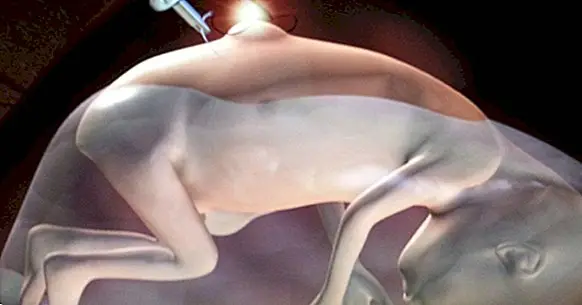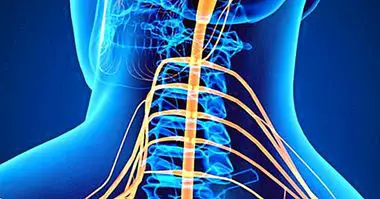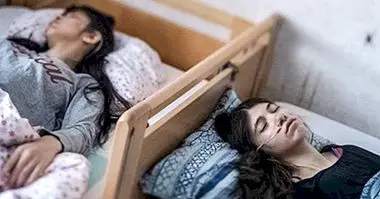Spina bifida: types, causes and treatment
The nervous system is one of the first components that begin to develop during our development, when we are still fetuses. Throughout the first month of pregnancy, in fact, already begins to close the neural tube that will configure our brain and spinal cord.
These will be surrounded and protected by the skull and spine. However, in some cases there is a malformation that prevents the neural tube and spine from closing, remaining open to some degree so that the nerve bundles it contains can suffer various injuries. We are talking about spina bifida .
- Related article: "Spinal cord: anatomy, parts and functions"
What is spina bifida?
We understand spina bifida a type of malformation produced during fetal development in which part of the neural tube does not completely close during the first month of pregnancy, so that the spine does not fully protect the nerves that go down through it and the spinal cord is exposed to injuries and injuries of varying severity. Sometimes this opening is visible, although in other cases it is hidden by the skin.
Spina bifida may not generate symptoms in some cases, but depending on the type of malformation, its location and the existence of possible damage to it can generate severe dangerous problems for the subject. The closer the brain is to the opening, the more serious of the symptomatology to be damaged a greater amount of nerves.
Some of the typical symptoms of subjects with spina bifida, specifically due to the presence of lesions in the marrow due to this malformation, may be the presence of gastrointestinal disorders, lack of control of the sphincters and urethra, weakness and lack of sensitivity of the lower limbs or the areas below the injury and it is even possible that there is a total paralysis of these areas.
It must be taken into account that in some cases the opening of the neural tube is very close to the skull and that it can generate alterations such as hydrocephalus or meningitis, with risk of mortality for the affected. Learning problems and even intellectual disabilities can occur in some cases.
- You may be interested: "The strange case of Noah, the child without a brain"
Types of spina bifida
Spina bifida is a problem that can occur in different ways, so it is possible to establish different subtypes depending on their characteristics.
1. Spina bifida oculi
It is the form of presentation with less repercussion for the subject, and it is the most common manifestation of spina bifida.
In this case one or more vertebrae have not formed correctly and may have openings, although the nervous tissue remains inside. The malformation is hidden by skin. The subject may have holes or bumps on the back . It does not usually cause serious disabilities, but there may be deformities, incontinence, insensibility in one of the limbs or weakness.
2. Cystic or open spina bifida
In this type of spina bifida part of the marrow or meninges protrude outside the vertebrae, having a high level of danger for the subject who suffers from the protruding nervous material and not being protected. These They usually form a sac full of cerebrospinal fluid and of the outstanding material that can be observed externally.
Within this type we can find two subtypes .
Meningocele
In this case we find a malformation in which the marrow meninges protrude , the injury may be exposed or protected by the skin. However, what stands out is only the meninx and cerebrospinal fluid, with the nerve bundles still inside the spine.
Myelomeningocele
This is the most severe form of spina bifida . In it the marrow is exposed and protrudes through the opening of the spine. In other words, bundles of nerve fibers do not have bone protection, but are exposed on the outside of the spine. It can suppose serious paralysis that prevents bipedal locomotion and the loss of sensitivity and strength of the innervated areas.
The possible causes
Spina bifida it is a congenital condition, although not hereditary . Although the elements and mechanisms that cause the neural tube does not finish closing are unknown, it is an alteration that occurs during the fetal development of the individual, and that is usually associated with the presence of low levels of folic acid during pregnancy . There is also speculation about the possibility that there is some kind of genetic influence.
There are other elements that can be risk factors , such as the use of certain psychotropic drugs during pregnancy (for example valproic acid), the presence of high fevers during this or the age at which pregnancy begins (adolescents and very old people may have greater risk).
Treatment
Spina bifida is a disorder that does not have a totally curative treatment , at least with regards to damaged nerves. However, it is possible to perform various types of surgery that allow repositioning neuronal matter and protect it.
In the case of subjects with spina bifida occulta, treatment may not be necessary (in fact, in many cases it is not detected until advanced ages). While there may be anchor problems of the marrow that during growth can cause problems. In this case, yes it would be necessary to perform surgery .
In cases of open spina bifida or cystic if an intervention is necessary. In the case of myelomeningocele it is necessary close the tube and protect the neural bundles . At present it is possible to perform the intervention even in the fetal stage, so that the problem is corrected before delivery so as to avoid more damage than already exists, although it is a matter of treatments that can pose a certain danger for the patient. fetus as for the mother.
Other problems of spine or bone derived from spina bifida may require treatments and surgeries beyond those described above. In cases with hydrocephalus, excess cerebrospinal fluid should also be treated.
Prevention in pregnancy
Another way to avoid this problem is through prevention. It is recommended that during pregnancy the future mother incorporates folic acid into her diet , or take supplements of this one.
Special caution is necessary with those adolescent or very old mothers, and in the case of an epileptic person who takes valproic acid to consult with his doctor or psychiatrist possible effects of this medicine or the possibility of using other anticonvulsants as an alternative.



















